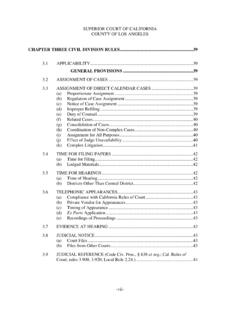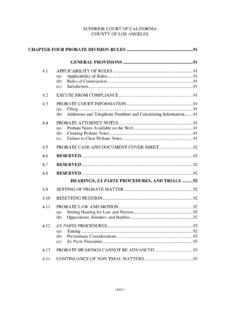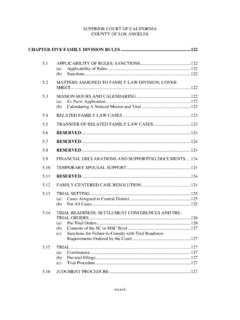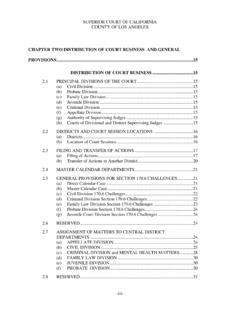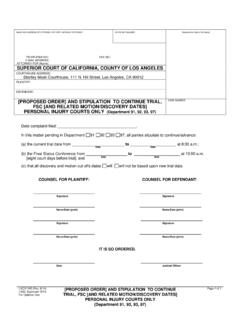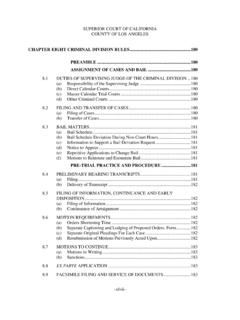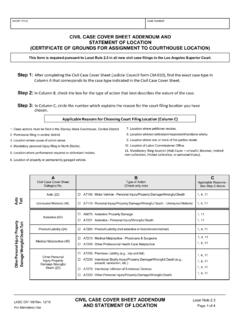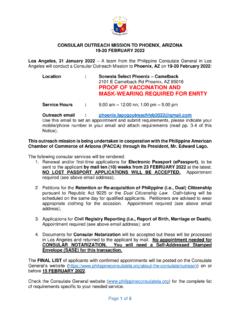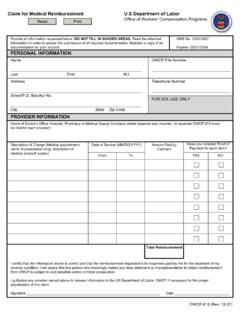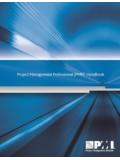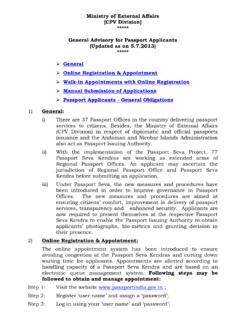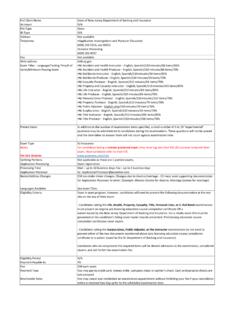Transcription of Superior Court of California, County of Los Angeles Civil ...
1 Page 1 of 11 Superior Court of California, County of Los Angeles Civil eFiling Frequently Asked Questions Revised 7/18/2019 1. IS THERE A GENERAL ORDER THAT GOVERNS EFILING FOR Civil ? Yes. The operative General Order Re Mandatory electronic Filing for Civil is posted on the Court s website at: The Court suggests that litigants read the order before reviewing these FAQs. 2. HOW DOES EFILING WORK? electronic filing of Court documents occurs through an el ectronic filing service provider (EFSP). The user creates an account and the efiling system manages the flow of the documents and fees to and from the Court . The filer will submit the documents to the EFSP for submission to the Court . The Court will accept or reject the documents. The documents are returned to the EFSP for return to the filer through the EFSP s el ectronic filing portal.
2 3. I AM A SELF-REPRESENTED LITIGANT. DO I HAVE TO EFILE? Self-represented litigants are not mandated to file documents electronically; however, they may choose to do so if desired. 4. IS EFILING MANDATORY? Yes. Litigants represented by attorneys in non-complex Civil cases must efile unless they have obtained a Court order for exemption. If you are an attorney who cannot use the efiling system, and your case is pending in the Central district, you may apply to Department 1 in the Stanley Mosk Courthouse for an exemption from mandatory electronic filing. If your case is pending in another district, you may apply to the supervising judge of that district for an exemption from mandatory electronic filing. You must use the Judicial Council Forms EFS-007 and 008. 5. WHAT ARE THE TECHNICAL REQUIRMENTS FOR DOCUMENTS BEING EFILED ?
3 Please refer to the Technical Requirements section of the operative General Order Re Mandatory electronic Filing for Civil . This section sets forth all of the Court s requirements for the formatting of the documents. 6. ARE ANY DOCUMENTS EXEMPT FROM EFILING? Yes. The following documents are excluded from efiling: Peremptory challenges or challenges for cause of a judicial officer pursuant to Code of Civil Procedure Sections or Bonds/undertaking documents Trial and evidentiary hearing exhibits Page 2 of 11 Any ex parte application filed concurrently with a new complaint, including those that will be assigned to the Writs and Receivers departments in the Stanley Mosk Courthouse. Documents submitted conditionally under seal. The actual motion or application shall be electronically filed.
4 A courtesy copy of the electronically filed motion or application to submit documents conditionally under seal must be provided with the documents submitted conditionally under seal and delivered directly to the courtroom to which the case is assigned. 7. HOW DO I OBTAIN AN ORDER FOR APPOINTMENT OF GUARDIAN AD LITEM? If your case requires the appointment of a guardian ad litem (GAL), the application and proposed order must be submitted with the initial complaint. Once the GAL is approved by the Court , the summons may be submitted for issuance by the clerk. 8. HOW DO I SUBMIT DOCUMENTS EXEMPT FROM EFILING? Except for lodged documents in support of a motion, documents that are exempt from efiling can be submitted for filing in the Clerk s Office of the Civil Division between the office hours of 8:30 and 4:30 or by mail (visit for courthouse addresses).
5 9. IS EFILING THE SAME AS FAX FILING? No. Efiling is not the same as fax filing. For efiling, the filing party must use an EFSP and submit documents for filing over the internet. With the exception of Small Claims and Complex, the Court will no longer accept fax filing for Civil documents. Once efiling is implemented for Complex, fax filing will no longer be available. 10. WILL FAX FILING STILL BE AVAILABLE AFTER EFILING IS IMPLEMENTED? No. Fax filing will not be available for Civil documents after efiling is implemented for each Civil case type. 11. IS EDELIVERY STILL AVAILABLE? No. Efiling has replaced eDelivery. For efiling, the filing party must select from a variety EFSPs and submit documents through the EFSP for filing over the internet. 12. CAN I USE MY PERSONAL COMPUTER TO EFILE? Yes. You can use your personal computer to submit filings through an EFSP.
6 You will use the internet to select the EFSP and submit your documents for filing. You will upload the document as an attachment. For instructions, refer to your EFSP s website. 13. WHICH EFSP CAN I USE? You may use any EFSP that is listed on the Court s website. You may view the EFSP list at: Page 3 of 11 14. WHY DO I HAVE TO REGISTER AS AN electronic FILER (EFILER)? Registration as an electronic filer is required to establish an account for your electronically filed documents. Your account will allow you to check the status of your electronically filed documents and will provide a path for the Court to return your documents to you. 15. CAN I CHANGE MY EFSP AFTER I HAVE CHOSEN AND REGISTERED WITH ONE? Yes. You may choose any EFSP. You may change to a different service provider at any time.
7 Selecting and using an EFSP is similar to using an attorney service for filings, except the types of filings processed are electronic . 16. DO I HAVE TO USE AN EFSP? Yes. The Judicial Council has mandated that all Courts accepting electronically filed documents use independent EFSPs. Pursuant to Code of Civil Procedure Section (e) the Court may not accept electronic filings directly. You can find a list of approved service providers on the Court s public website at: 17. IS THERE A COST TO EFILE? Yes. The Court and the EFSP will charge for efiling and all fees are collected by the EFSP when the filing is submitted. For Court fees related to electronic filing, refer to the Court s official fee schedule at: 18. ARE EFILING FEES RECOVERABLE? Efiling fees may be recoverable pursuant to Code of Civil Procedure Section 19.
8 WHAT TYPE OF PAYMENTS DO YOU ACCEPT? Please check with the EFSP of your choosing for specific information regarding payment types. Credit cards and electronic checks are accepted. 20. DO Court -APPOINTED ATTORNEYS HAVE TO EFILE AND PAY THE FEES FOR EFILING? Absent a fee waiver, fees are required for all filings, including filings from Court -appointed attorneys. 21. ONCE I EFILE A document , WHAT IS THE TIME FOR PROCESSING? Turnaround time will depend on the type of document filed. The Court attempts to confirm the filing or receipt of documents within two business days. Proposed orders, writs, abstracts, and other documents requiring review and/or further action by the Court may take longer than two days to process. 22. ARE MY EFILED DOCUMENTS PRINTED FOR THE Court FILE? No. Documents that are electronically filed and accepted by the Court are automatically uploaded to the Court s case management system.
9 This allows Court staff and judicial officers to electronically view the Page 4 of 11 case documents without printing the documents or maintaining physical Court files. The electronic record is the official Court record pursuant to Government Code Section 68150(a). 23. WHAT ARE THE FILING HOURS FOR EFILING? You may submit your filings electronically 24 hours a day. Any efiling received by the Court before midnight will be deemed received or filed on the same business day if accepted. Any efiling submitted after midnight will be deemed received or filed as of the next business day if accepted. 24. ARE DOCUMENTS AVAILABLE TO THE PUBLIC UPON SUBMISSION OR UPON PROCESSING? Filing parties may view submitted documents immediately through their EFSP s portal. All other parties will be able to view a document from the internet, or on public terminals located at any Los Angeles County courthouse, after filing by the Court if the person opens an account with the Court which requires payment of fee.
10 A document is not considered filed until it is accepted by the Court . However, unlimited Civil complaints will be available to the media upon submission, prior to review for acceptance by the Court . 25. DOES THE Court HAVE A POLICY REGARDING DOCUMENTS EFILED ON THE LAST DAY? No. Statutory requirements apply for preservation of any statute of limitation on filings, including those submitted electronically. Efiling does not change the last day to file requirements. 26. WHAT DO I DO IF MY document IS REJECTED? Any Notice of Rejection sent by the Court will include the reason for the return of the document . If your document is rejected, correct the deficiency and resubmit the document via eFiling. If the document is not timely filed as a result of the rejection or filing error, you will need to apply to the Court for relief or other corrective order.
